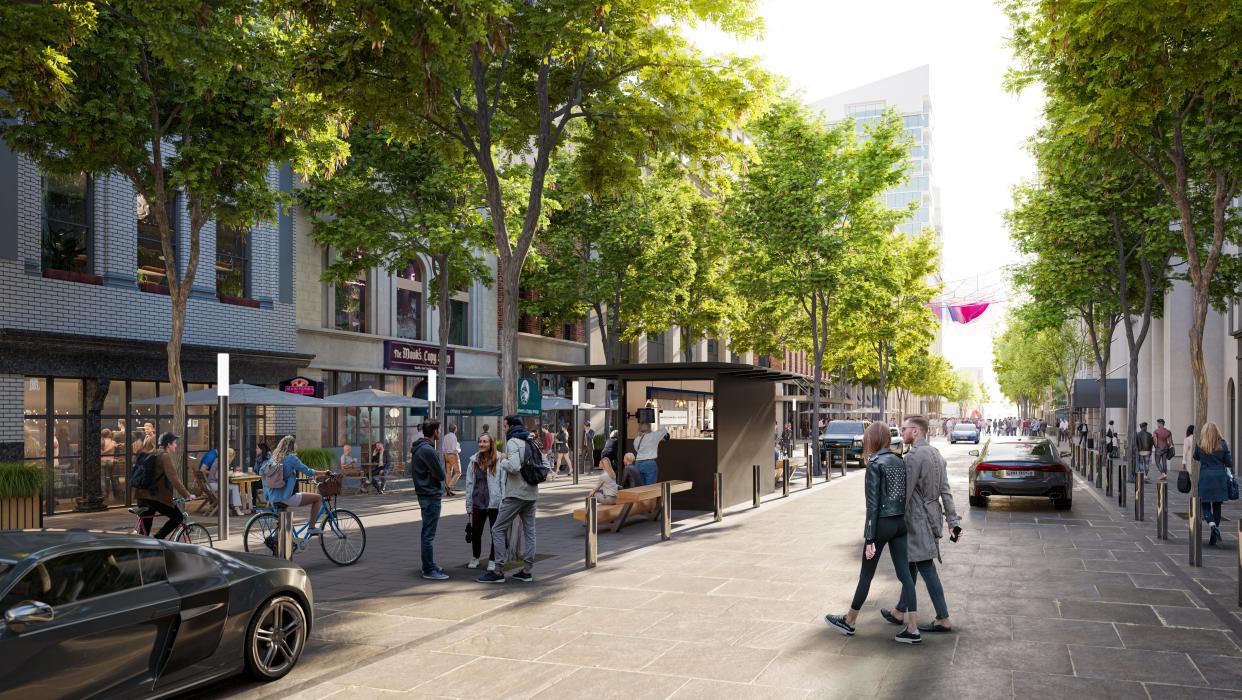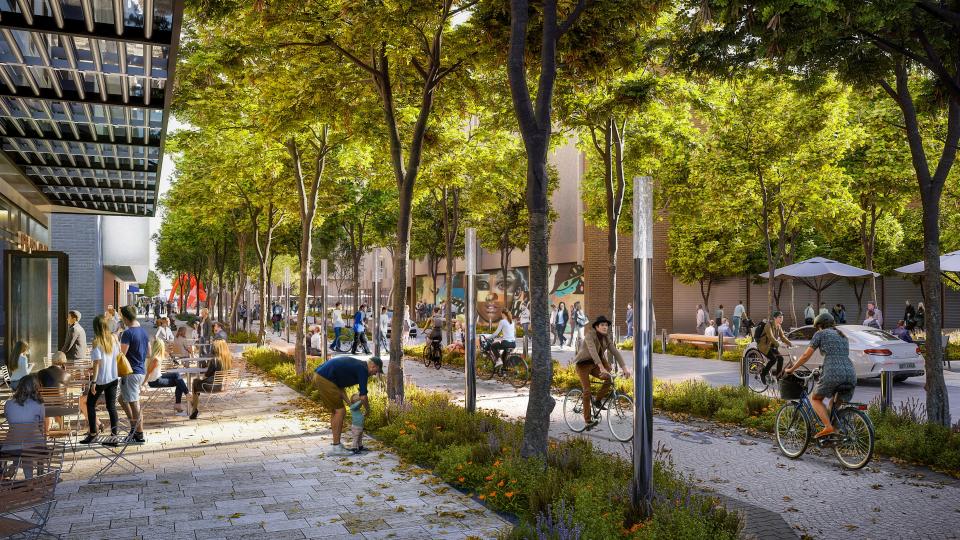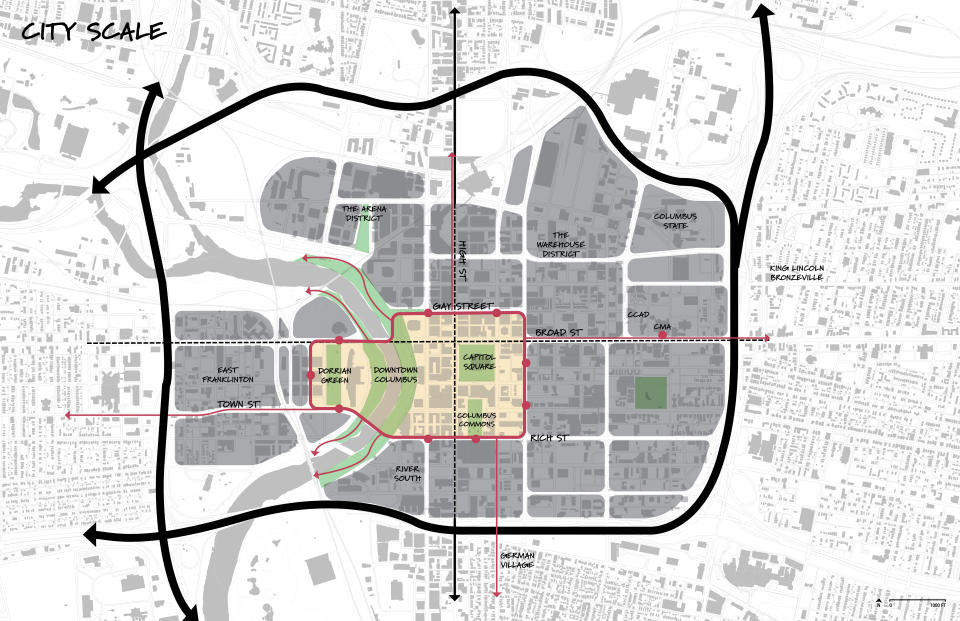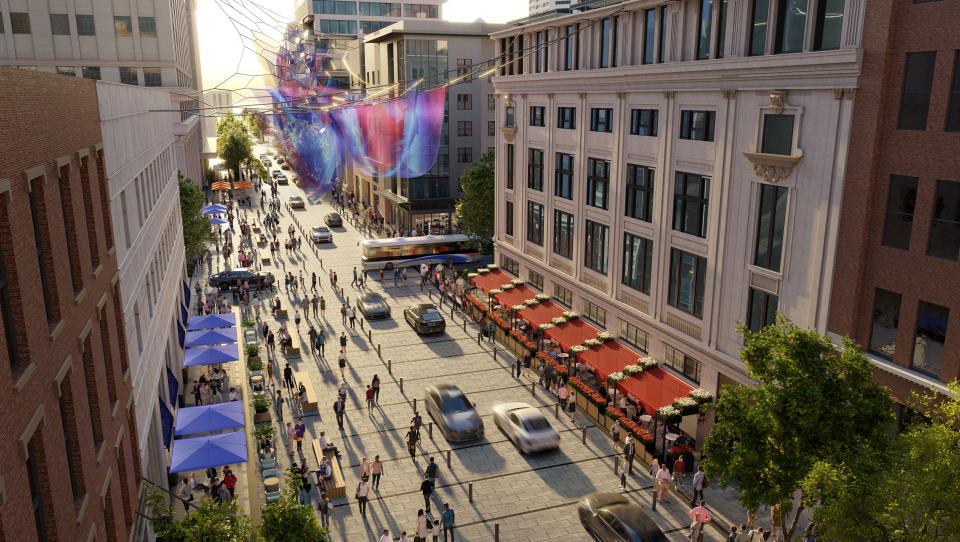Bike friendly Downtown: See $100 million plan to swap road lanes for pedestrian passages

- Oops!Something went wrong.Please try again later.
A two-mile bike and pedestrian path, dotted with greenery, art and furniture, will loop through Downtown under a $100-million plan proposed Wednesday by city officials and a Columbus developer.
Called The Capital Line, the pathway would run along Gay, Rich and 4th streets before crossing the river and closing the loop on Belle Street in Franklinton.
Ranging from about 12 feet up to potentially 30 wide including landscaping, the pathway would replace what is now street space, including parking lanes.
More: Columbus launches program to help fill empty Downtown retail spaces
The project is a partnership between the city of Columbus, the Columbus Downtown Development Corp., and Edwards Companies development firm, which is pursuing several Downtown projects along the route of the path. The CDDC would oversee the project.
"The city of Columbus and in some cases public-private partnerships have done a fabulous job with Downtown assets such as the Scioto Mile, the Peninsula and Columbus Commons, but if you’ve ever walked between those places, it’s not such a great experience from a pedestrian perspective," said Edwards Companies CEO Jeff Edwards, who unveiled the plan Wednesday at the Columbus Metropolitan Club with Mayor Andrew Ginther.
"If we want to cater to residents, we need to start connecting these things in a pedestrian-friendly way."

Final plans have not been drawn, but the pathway is expected to cost about $100 million and take four years to complete, said Ginther and CDDC President Amy Taylor.
Funding would come from private, public and philanthropic sources, they said. Edwards paid for the preliminary studies and renderings, and the Ohio House has proposed $10 million for the project from the state's "Super Duper Fund" of leftover federal COVID-19 dollars.
Beyond that, Taylor said a funding package would be put together when more detailed plans and costs are set. Taylor said the CDDC is "in the process of looking for a design and engineering firm" for the pathway.
"This is a top priority for me," Ginther said Wednesday when presenting the plan.
"We’re still the heart and soul of this region," he added. "There is no Granville, there is no Newark, there is no Grove City and there is no Dublin or New Albany without a strong, healthy, vibrant Downtown and that’s why the Capital Line project is so important, to be investing in ourselves for the future."

Preliminary plans call for the pathway to occupy what is now the street or parking lane and be separated from traffic by landscaping or other barriers, freeing some of the existing sidewalk for other uses such as outdoor restaurant seating.
The Capital Line route was designed along streets wide enough to accommodate it, and to link several Downtown destinations including the Scioto Mile riverfront, National Veterans Memorial & Museum, Columbus Commons, the Statehouse, The Peninsula development, Dorian Green and COSI.
Broad Street, which serves as an eight-lane chasm through Downtown, was not considered for the pathway because other plans are in the works to improve it, Edwards said.
Ginther, Taylor and Edwards said spurs could eventually be added connecting the trail to other neighborhoods such as Victorian Village, Olde Towne East, King-Lincoln-Bronzeville and German Village.
Supporters say the Capital Line is a response to community suggestions in the 2022 Downtown Columbus Strategic Plan "to activate and invigorate the Downtown pedestrian experience" and to offer protected bike lanes.
City officials and Edwards also hope the pathway will "catalyze" development Downtown, which has struggled since COVID sent many workers home. They say the Indianapolis Cultural Trail, an eight-mile walk connecting many of the city's Downtown attractions, has generated an economic impact of $1 billion. That trail cost about $63 million when completed in 2013.
Edwards said he and others visited the Indianapolis trail while researching one for Columbus, and examined similar trails such as the Underline in Miami, the Atlanta BeltLine and the 5280 Trail planned for Denver.

The Capital Line will proceed in stages. Construction of the first phase, on Gay Street, is expected to begin in 2025 and coincide with other updates to Gay Street such as removing curbs.
Ginther, Taylor and Edwards said they're not worried about impeding car traffic by removing street lanes, in part because Downtown isn't as busy as it once was.
“The volume of vehicles was different than it is now,” Edwards said. “Those roads are designed for a different time, and 100% with cars in mind. We’re right-sizing these roads.”
jweiker@dispatch.com
@JimWeiker
This article originally appeared on The Columbus Dispatch: Columbus Capital Line would invest $100 million into downtown paths

